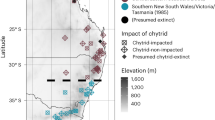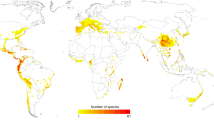Abstract
Amphibian populations have suffered widespread declines and extinctions in recent decades. Although climatic changes, increased exposure to ultraviolet-B (UV-B) radiation and increased prevalence of disease have all been implicated at particular localities1,2,3,4,5,6, the importance of global environmental change remains unclear. Here we report that pathogen outbreaks in amphibian populations in the western USA are linked to climate-induced changes in UV-B exposure. Using long-term observational data and a field experiment, we examine patterns among interannual variability in precipitation, UV-B exposure and infection by a pathogenic oomycete, Saprolegnia ferax. Our findings indicate that climate-induced reductions in water depth at oviposition sites have caused high mortality of embryos by increasing their exposure to UV-B radiation and, consequently, their vulnerability to infection1. Precipitation, and thus water depth/UV-B exposure, is strongly linked to El Niño/Southern Oscillation cycles, underscoring the role of large-scale climatic patterns involving the tropical Pacific7. Elevated sea-surface temperatures in this region since the mid-1970s, which have affected the climate over much of the world8, could be the precursor for pathogen-mediated amphibian declines in many regions1,3,4,9.
This is a preview of subscription content, access via your institution
Access options
Subscribe to this journal
Receive 51 print issues and online access
$199.00 per year
only $3.90 per issue
Buy this article
- Purchase on Springer Link
- Instant access to full article PDF
Prices may be subject to local taxes which are calculated during checkout


Similar content being viewed by others
References
Kiesecker, J. M. & Blaustein, A. R. Synergism between UV-B radiation and a pathogen magnifies amphibian embryo mortality in nature. Proc. Natl Acad. Sci. USA 92, 11049–11052 (1995).
Blaustein, A. R. et al. UV repair and resistance to solar UV-B in amphibian eggs: a link to population declines? Proc. Natl Acad. Sci. USA 91, 1791–1795 (1994).
Berger, L. et al. Chytridiomycosis causes amphibian mortality associated with population declines in the rainforests of Australia and Central America. Proc. Natl Acad. Sci. USA 95, 9031–9036 (1998).
Pounds, J. A., Fogden, M. P. L. & Campbell, J. H. Biological response to climate change on a tropical mountain. Nature 398, 611–615 (1999).
Beebee, T. J. C. Amphibian breeding and climate. Nature 374, 219–220 (1995).
Houlahan, J. E., Findlay, C. S., Schmidt, B. R., Meyer, A. H. & Kuzmin, S. L. Quantitative evidence for global amphibian population declines. Nature 404, 752–755 (2000).
Guilderson, T. P. & Schrag, D. P. Abrupt shift in subsurface temperatures in the Tropical Pacific associated with changes in El Niño. Science 281, 240–243 (1998).
Graham, N. E. Simulation of recent global temperature trends. Science 267, 661–671 (1995).
Pounds, J. A. & Crump, M. L. Amphibian declines and climate disturbance: the case of the golden toad and the harlequin frog. Conserv. Biol. 8, 72–85 (1994).
Blumthaler, M. & Ambach, W. Indication of increasing solar ultraviolet-b radiation flux in alpine regions. Science 248, 206–208 (1990).
Kerr, J. B. & McElroy, C. J. Evidence for large upward trends of ultraviolet-b radiation linked to ozone depletion. Science 262, 1032–1034 (1993).
Stolarski, R. et al. Measured trends in stratospheric ozone. Science 256, 342–349 (1992).
Häder, D. P. Impact of UVB on aquatic organisms. Photochem. Photobiol. 69, S23–S32 (1999).
Schindler, D. W., Curtis, P. J., Parker, B. R. & Stainton, M. P. Consequences of climate warming and lake acidification for UV-B penetration in North American boreal lakes. Nature 379, 705–708 (1996).
Yan, N. D., Keller, W., Scully, N. M., Lean, D. R. S. & Dillon, P. J. Increased UV-B penetration in a lake owing to drought-induced acidification. Nature 381, 141–143 (1996).
Nussbaum, R. A., Brodie, E. D. & Storm, R. M. Amphibian and Reptiles of the Pacific Northwest (Idaho Univ. Press, Moscow, Idaho, 1983).
Stebbins, R. C. & Cohen, N. W. A Natural History of Amphibians (Princeton Univ. Press, New Jersey, 1995).
Kiesecker, J. M. & Blaustein, A. R. Influences of egg laying behavior on pathogenic infection of amphibian eggs. Conserv. Biol. 12, 214–220 (1997).
Blaustein, A. R., Hokit, D. G., O'Hara, R. K. & Holt, R. A. Pathogenic fungus contributes to amphibian losses in the Pacific Northwest. Biol. Conserv. 67, 251–254 (1994).
Kiesecker, J. M. & Blaustein, A. R. Pathogen reverses competition between larval amphibians. Ecology 80, 2442–2448 (1999).
Blaustein, A. R. & Kiesecker, J. M. in The Effects of Ozone Depletion on Aquatic Ecosystems (ed. Hädar, D. P.) 175–188 (R.G. Landes, Austin, Texas, 1997).
Redmond, K. T. & Koch, R. W. Surface climate and streamflow variability in the western United States and their relationship to large-scale circulation indexes. Water Resourc. Res. 27, 2381–2399 (1991).
Meehl, G. A. & Washington, W. M. El Niño-like climate change in a model with increased atmospheric CO2 concentrations. Nature 382, 56–60 (1996).
Timmermann, A. et al. Increased El Niño frequency in a climate model forced by future greenhouse warming. Nature 398, 694–697 (1999).
Lips, K. R. Decline of a tropical montane amphibian fauna. Conserv. Biol. 12, 106–117 (1996).
Laurance, W. F., McDonald, K. R. & Speare, R. Epidemic disease and the catastrophic declines of Australian rain forest frogs. Conserv. Biol. 10, 406–413 (1996).
Epstein, P. R. Perspectives: Medicine, climate and health. Science 285, 347–348 (1999).
Hughes, L. Biological consequences of global warming: is the signal already apparent? Trends Ecol. Evol. 15, 56–61 (2000).
Post, E., Peterson, R. O., Stenseth, N. C. & McKaren, B. E. Ecosystem consequences of wolf behavioural response to climate. Nature 401, 905–907 (1999).
Lima, M., Keymer, J. E. & Jaksic, F. M. El Niño-Southern oscillation-driven rainfall variability and delayed density dependence cause rodent outbreaks in western South America: linking demography and population dynamics. Am. Nat. 153, 476–491 (1999).
Acknowledgements
We thank the U.S. Forest Service, Pacific Northwest Research Station and D. H. Olson for the use of vehicles and temperature data loggers, and D. G. Hokit and S. Walls for discussions regarding experimental design. We also thank G. Taylor from the Oregon State Climate Center for help with obtaining the climate data. J. A. Pounds, E. Post, M. Vronsky and N. Chevoteravich provided helpful suggestions on this manuscript. Funding was provided by the Declining Amphibian Population Task Force Seed Grant (to J.M.K.); NIH/NSF Ecology of Infectious Diseases grant (to J.M.K.); and the Department of Biology, Pennsylvania State University.
Author information
Authors and Affiliations
Corresponding author
Rights and permissions
About this article
Cite this article
Kiesecker, J., Blaustein, A. & Belden, L. Complex causes of amphibian population declines. Nature 410, 681–684 (2001). https://doi.org/10.1038/35070552
Received:
Accepted:
Issue Date:
DOI: https://doi.org/10.1038/35070552
This article is cited by
-
Using genome-wide data to ascertain taxonomic status and assess population genetic structure for Houston toads (Bufo [= Anaxyrus] houstonensis)
Scientific Reports (2024)
-
Integrating genomics into the genetic management of the endangered mountain yellow-legged frog
Conservation Genetics (2024)
-
Linking microbiome and stress hormone responses in wild tropical treefrogs across continuous and fragmented forests
Communications Biology (2023)
-
Elevated alpha diversity in disturbed sites obscures regional decline and homogenization of amphibian taxonomic, functional and phylogenetic diversity
Scientific Reports (2023)
-
Realistic scenarios of pesticide exposure alters multiple biomarkers in BOANA PULCHELLA (ANURA) Adult Frogs
Ecotoxicology (2023)
Comments
By submitting a comment you agree to abide by our Terms and Community Guidelines. If you find something abusive or that does not comply with our terms or guidelines please flag it as inappropriate.



